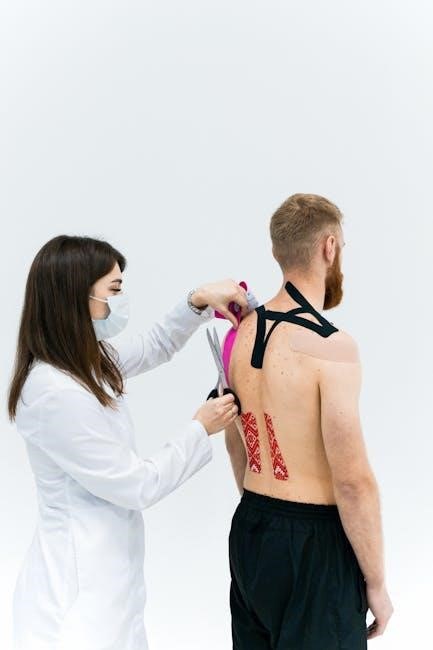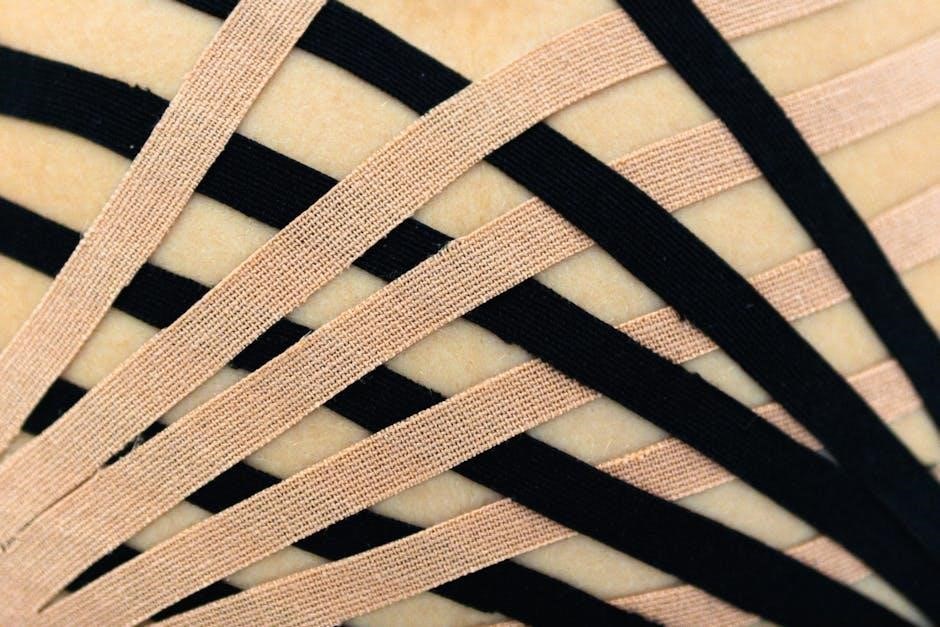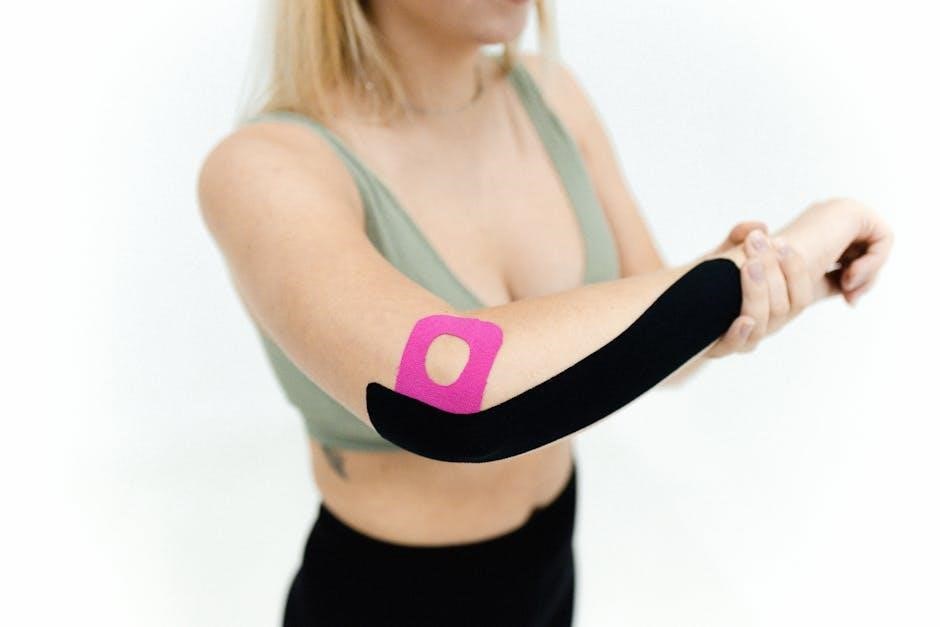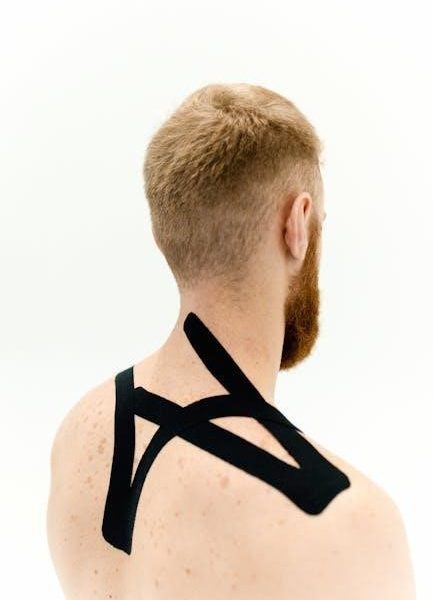Kinesio taping is a non-invasive method using elastic tape to relieve pain and support joints, widely used for tennis elbow. It improves mobility and reduces discomfort, backed by research.
What is Kinesio Taping?
Kinesio taping is a non-invasive therapeutic method that involves applying a specially designed elastic tape to the skin. Originating in Japan in the 1970s, it was developed to mimic the properties of human skin, providing support and stability to muscles and joints while allowing for a full range of motion. Unlike traditional athletic tape, Kinesio tape is flexible and breathable, making it suitable for long-term wear. Its primary purposes include reducing pain, improving blood and lymph circulation, and enhancing joint mobility. The tape is applied in specific patterns to address various injuries and conditions, such as tennis elbow, by lifting the skin to relieve pressure on underlying tissues. This method has gained popularity worldwide among athletes, physical therapists, and healthcare professionals for its ability to promote healing and improve physical function without restricting movement. It is often used alongside other therapies to enhance recovery and performance.
The History and Development of Kinesio Taping
Kinesio taping was first introduced in Japan in the 1970s by Dr. Kenzo Kase, a chiropractor who sought to create a therapeutic tape that mimicked the elasticity of human skin. Initially designed to provide support and stability without restricting movement, the tape gained popularity in the 1990s and 2000s as its benefits became widely recognized. Its use expanded globally, particularly among athletes and physical therapists, after its prominence at the 2008 Beijing Olympics. Since then, Kinesio taping has evolved into a versatile tool for treating injuries, improving circulation, and enhancing recovery. Its development has led to various applications, including specific techniques for conditions like tennis elbow, making it a cornerstone in modern rehabilitation practices.
How Kinesio Taping Works for Tennis Elbow
Kinesio taping works by gently lifting the skin to reduce pressure on pain receptors and improve blood and lymph circulation. For tennis elbow, the tape is applied to support the affected tendons and muscles, reducing strain and discomfort. The elastic properties of the tape allow for a full range of motion while providing stability. It is often applied with varying degrees of tension depending on the desired therapeutic effect. The tape can help relieve pain by altering sensory feedback and reducing inflammation. When applied correctly, it supports the natural healing process without restricting movement, making it an effective adjunct to other treatments for tennis elbow. Research suggests it is most beneficial in the early stages of the condition, helping to manage symptoms and facilitate recovery.

Benefits of Kinesio Taping for Tennis Elbow
Kinesio taping alleviates tennis elbow symptoms by lifting the skin to reduce pressure on pain receptors, enhancing blood and lymph circulation, and providing support to tendons and muscles. The tape’s elasticity allows for a full range of motion while stabilizing the affected area, reducing strain and discomfort. It facilitates healing by improving circulation, which delivers nutrients and oxygen to injured tissues, and by reducing inflammation, which minimizes swelling. The tape can be applied with varying tension to suit therapeutic needs, and its application techniques may vary depending on the severity of the condition. It is a beneficial adjunct to other treatments, particularly in the early stages, aiding in symptom management and recovery without restricting movement.

Pain Reduction and Comfort
Kinesio taping is highly effective in reducing pain and discomfort associated with tennis elbow. By gently lifting the skin, the tape reduces pressure on pain receptors, providing immediate relief. The tape’s elastic properties allow for a full range of motion while offering consistent support, minimizing strain on the affected tendons and muscles. This unique combination of support and flexibility helps alleviate the sharp pains often experienced during movement. Improved circulation from the tape also reduces inflammation and swelling, further enhancing comfort. Many users report a noticeable decrease in discomfort within hours of application, making it an ideal solution for both acute and chronic cases. The tape’s ability to provide ongoing support without restricting movement makes it a preferred option for athletes and individuals seeking non-invasive pain management.
Improved Blood and Lymph Circulation
Kinesio taping significantly enhances blood and lymph circulation, which is crucial for healing tennis elbow. The tape’s gentle lifting effect on the skin reduces pressure on blood vessels, promoting better blood flow to the injured area. Improved circulation delivers oxygen and nutrients to damaged tissues, accelerating the repair process. Additionally, the tape facilitates lymphatic drainage, reducing swelling and inflammation by removing excess fluids and toxins. Enhanced lymphatic circulation also helps minimize the buildup of lactic acid in muscles, further reducing fatigue and discomfort. This dual effect on blood and lymph flow creates an optimal environment for recovery, making Kinesio taping a valuable tool for managing tennis elbow and supporting the body’s natural healing mechanisms.
Enhanced Joint and Muscle Mobility
Kinesio taping is renowned for its ability to enhance joint and muscle mobility, making it an excellent solution for tennis elbow. By applying gentle, strategic tension, the tape supports the elbow joint without restricting its natural range of motion. This allows individuals to move freely during daily activities or sports, reducing stiffness and promoting fluid movement. The tape also helps stabilize overused or strained muscles, preventing further injury while maintaining flexibility. For tennis elbow sufferers, this means improved grip strength, less strain during forearm rotations, and better overall function. Enhanced mobility enables patients to resume normal activities or athletic performance more quickly, aiding in both recovery and rehabilitation. The tape’s elasticity mimics the skin’s natural elasticity, ensuring uninterrupted movement and comfort.

Application Techniques for Kinesio Taping
Proper skin preparation and alignment are crucial. Apply Y-Strips for support and I-Strips for targeted pain relief. Follow specific tension guidelines for optimal results and comfort during movement.

Step-by-Step Guide to Applying Kinesio Tape
Begin by cleaning and drying the skin to ensure proper adhesion. Shave the area if necessary. Apply Y-Strips with the base at the elbow joint, extending the arms up and down the forearm with light to moderate tension. Secure I-Strips over the lateral epicondyle for targeted support. Use one or two I-Strips, applied vertically or horizontally, depending on pain location. Remove the tape gently, peeling slowly from the skin to avoid irritation. For longevity, avoid excessive sweating and moisture. Reapply as needed, following the same steps. For acute cases, focus on support and less tension; for chronic cases, adjust techniques to address inflammation and muscle fatigue; Consult a professional for complex conditions and to ensure proper application techniques.
Common Taping Methods for Tennis Elbow
Several taping methods are widely used to address tennis elbow, each offering unique benefits. The Y-Strip method involves placing a Y-shaped strip at the elbow joint, with arms extending toward the forearm and bicep. This provides lateral support and reduces strain on the tendons. The I-Strip technique uses vertical or horizontal strips directly over the affected area to relieve pain and inflammation. Fan cuts, which involve cutting the tape into strips at one end, allow for a broader distribution of force and improved circulation. Cross taping, where strips are layered in a crisscross pattern, enhances stability and compression. These methods can be combined or adapted based on the severity of symptoms and individual needs. For optimal results, it’s important to tailor the taping method to the specific condition and consult a professional for advanced or chronic cases.
Using Y-Strips and I-Strips for Optimal Support
Y-Strips and I-Strips are essential components of Kinesio taping for tennis elbow, offering targeted support and pain relief. Y-Strips are applied in a Y-shape, with the base of the “Y” placed at the elbow joint and the arms extending toward the forearm and bicep. This configuration provides lateral support and helps reduce strain on the tendons. I-Strips, on the other hand, are straight strips applied directly over the affected area, such as the lateral epicondyle, to relieve tension and pain. Both methods can be used together for enhanced support, with Y-Strips addressing joint stability and I-Strips focusing on pain alleviation. Proper application involves stretching the tape gently to avoid restricting movement while ensuring adequate adhesion. This combination is particularly effective for individuals with moderate to severe tennis elbow symptoms, promoting both comfort and functional mobility.
Advanced Taping Techniques for Chronic Cases
For individuals with chronic tennis elbow, advanced Kinesio taping techniques can provide additional support and pain relief. One method involves using cross-taping, where multiple strips are layered to create a reinforced web-like structure over the affected area. This technique helps distribute tension evenly and reduces strain on the tendons. Another approach is fan taping, where the tape is applied in a fanned-out pattern to cover a larger surface area, promoting lymphatic drainage and reducing inflammation. These techniques often incorporate additional strips to stabilize the forearm muscles and improve joint alignment. Advanced methods may also involve combining Kinesio tape with other therapies, such as massage or heat therapy, for enhanced recovery. Proper training and guidance from a certified practitioner are recommended to ensure correct application and maximize benefits for chronic cases.

Effectiveness of Kinesio Taping
Kinesio taping alleviates pain and inflammation, supports muscles and tendons, enhances mobility, and promotes healing for tennis elbow, offering a non-invasive solution to improve function and reduce discomfort effectively.

Scientific Studies on Kinesio Taping for Tennis Elbow
Scientific research on Kinesio taping for tennis elbow has yielded mixed results. Some studies suggest that it can reduce pain and improve functional ability, while others indicate limited therapeutic benefits. A 2018 systematic review found that Kinesio taping provided short-term pain relief and improved grip strength compared to no treatment. However, when compared to other interventions like braces or physical therapy, the differences were less significant. Another study published in 2020 highlighted that the tape’s effectiveness may vary depending on the severity of the condition and individual patient characteristics. Despite the debate, many practitioners and patients report positive outcomes, particularly when combined with other treatments. Further research is needed to establish definitive guidelines for its use in managing tennis elbow.
Comparison with Other Treatments (Bracing, Splinting)
Kinesio taping is often compared to bracing and splinting for tennis elbow management. Unlike rigid braces or splints, Kinesio tape allows for full joint mobility while providing support. Bracing and splinting are more restrictive, immobilizing the elbow to reduce strain on the tendons. Studies show that Kinesio taping can be as effective as bracing in reducing pain and improving function, especially in acute cases. However, splinting may offer better stability for severe or chronic conditions. Kinesio taping is favored for its lightweight, breathable design and ability to promote blood flow, whereas braces can sometimes cause discomfort or restrict movement. The choice between these methods often depends on the severity of symptoms and patient preference. Combining Kinesio taping with other therapies, such as physical therapy, may enhance outcomes compared to using bracing or splinting alone.
When is Kinesio Taping Most Effective?
Kinesio taping is most effective for tennis elbow when used in the acute phase to reduce pain and inflammation. It provides immediate support and stability without restricting movement, making it ideal for mild to moderate cases. The tape can be applied before activities to prevent strain or after injury to aid recovery. Its effectiveness increases when combined with other therapies like physical therapy or bracing. Proper application techniques are crucial for optimal results. For chronic cases, taping may need to be part of a comprehensive treatment plan. Generally, Kinesio tape can be worn for several days but should be removed and reapplied as needed. While accessible and widely used, effectiveness may vary based on individual conditions and application methods.

Practical Considerations
Proper application, skin preparation, and individual needs are key. Tape should be applied on clean, dry skin, avoiding irritants. Duration of wear and reapplication depends on activity levels and comfort.
When to Use Kinesio Taping
Kinesio taping is most effective when applied during the acute or chronic phases of tennis elbow. It is ideal for reducing pain and inflammation during activity or rest. Use it before sports, physical therapy, or daily tasks to provide stability and support. Apply the tape as a preventive measure to avoid aggravating the condition. For chronic cases, taping can be part of ongoing management to enhance recovery. It is also beneficial post-injury to promote healing and restore function. Taping is particularly useful for individuals who need to maintain mobility while managing discomfort. Always consult a professional to determine the best timing and method for your specific condition to ensure optimal results and avoid contraindications.
How Long to Wear the Tape
Kinesio tape can typically be worn for 3 to 5 days, depending on the individual’s activity level and skin sensitivity. It is water-resistant, allowing wear during showers or swimming. For tennis elbow, the tape is often applied before activity and left on for up to 24 hours after application. However, if irritation or discomfort occurs, it should be removed sooner. The adhesive properties may weaken over time, reducing effectiveness. Reapplication may be necessary if the tape loses its grip or if symptoms persist. Always follow professional advice tailored to your condition. Avoid leaving the tape on for extended periods if skin irritation develops. Proper removal involves peeling the tape slowly to prevent skin damage. Replacement frequency and duration should align with your specific treatment goals and comfort level.
Precautions and Contraindications
When using Kinesio tape for tennis elbow, there are several precautions to consider. Individuals with sensitive skin may experience irritation or allergic reactions to the adhesive. In such cases, a hypoallergenic tape is recommended. The tape should not be applied over open wounds, cuts, or infected areas. Additionally, Kinesio taping is contraindicated for individuals with circulatory or lymphatic system disorders, as it may worsen these conditions. It is also not advised for those with severe swelling or eczema near the affected area. For pregnant women or individuals with cancer, consult a healthcare professional before using Kinesio tape. Proper application by a trained practitioner is essential to avoid complications. Avoid tight wrapping, as this can restrict blood flow or worsen symptoms. Always monitor skin reactions and discontinue use if discomfort or irritation persists. Professional guidance is recommended for severe cases or underlying medical conditions.

Maintenance and Reapplication Tips
To ensure the effectiveness of Kinesio tape for tennis elbow, proper maintenance and reapplication are essential. Daily inspection of the tape is recommended to check for peeling or fraying edges, which can reduce its adhesive properties. Gently cleaning the skin before reapplication with a mild soap and water ensures better adhesion. Avoid using lotions or oils on the skin, as they can weaken the tape’s grip. Reapply the tape every 3-5 days or as needed, especially after swimming or excessive sweating. When reapplying, remove the old tape slowly and gently to avoid skin irritation. Use a fresh strip for optimal support and adhesion. For sensitive skin, consider using latex-free or hypoallergenic Kinesio tape. Store unused tape in a cool, dry place to maintain its quality. Regularly trimming loose ends with scissors can also extend the tape’s durability. Always follow proper removal techniques to prevent skin damage or irritation.

Resources and Further Reading
Explore detailed PDF guides, video tutorials, and research articles on Kinesio taping for tennis elbow to enhance your understanding and application techniques. Expert recommendations and case studies are also available for deeper insights.
Recommended PDF Guides on Kinesio Taping
Discover comprehensive PDF guides specifically designed for Kinesio taping techniques tailored to tennis elbow. These resources often include detailed step-by-step instructions, illustrations, and case studies to help users master the application process. Many guides are authored by physical therapists or sports medicine experts, ensuring evidence-based advice. Topics typically covered include pain relief methods, improving circulation, and enhancing mobility. Some PDFs also explore advanced taping strategies for chronic conditions. These guides are ideal for athletes, therapists, and individuals seeking self-care solutions. They are widely available on sports medicine websites, Kinesio official resources, and online academic databases. Downloading these PDFs provides a convenient way to access expert knowledge and apply effective taping techniques for tennis elbow recovery and prevention.
Video Tutorials for Application Techniques
Video tutorials are an excellent resource for mastering Kinesio taping techniques for tennis elbow. These visual guides provide step-by-step demonstrations, making it easier to understand and apply the tape correctly. Many videos are created by certified physical therapists or sports trainers, ensuring accurate and effective methods. They often cover basic techniques, such as applying Y-strips or I-strips, as well as more advanced strategies for chronic cases. Platforms like YouTube, Kinesio official websites, and sports therapy channels offer a wide range of tutorials tailored to different skill levels. Watching these videos allows users to see how the tape should be positioned, stretched, and smoothed for optimal results. They also highlight common mistakes to avoid, ensuring a safe and effective taping experience. These tutorials are particularly useful for those who prefer visual learning or need guidance on proper application techniques.
Research Articles and Studies on Kinesio Taping
Research articles and studies on Kinesio taping provide valuable insights into its efficacy for tennis elbow. These publications, often found in sports medicine and physical therapy journals, explore the tape’s impact on pain reduction, inflammation, and functional improvement. Many studies compare Kinesio taping with traditional treatments like bracing or splinting, offering evidence-based conclusions. Platforms like PubMed, Google Scholar, and Sports Medicine journals host numerous peer-reviewed articles. Some studies suggest that Kinesio taping enhances proprioception and reduces muscle fatigue, while others highlight its role in improving grip strength and mobility. However, findings vary, with some research indicating limited evidence for its benefits. For those seeking in-depth analysis, searching for systematic reviews or meta-analyses on Kinesio taping for tennis elbow can provide comprehensive summaries of existing research.
Expert Recommendations and Case Studies
Experts in sports medicine and physical therapy often recommend Kinesio taping as a complementary treatment for tennis elbow, particularly for its non-invasive nature. Case studies highlight its effectiveness in reducing pain and improving functional mobility in athletes and individuals with chronic conditions. Many practitioners suggest combining Kinesio taping with other therapies, such as eccentric exercises or ultrasound therapy, for optimal results. Specific application techniques, such as the “Y-strip” method, are frequently endorsed for targeting the affected tendons; Some case studies document significant improvements in grip strength and reduced inflammation within weeks of consistent use. However, experts emphasize proper training in taping techniques to avoid adverse effects. For those exploring this method, consulting certified professionals or reviewing detailed case studies from reputable sources is highly recommended.
